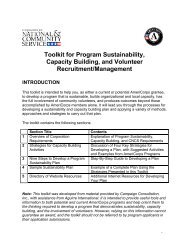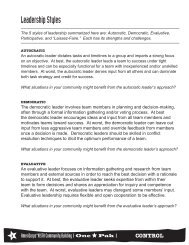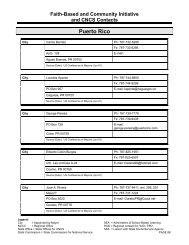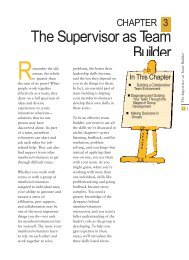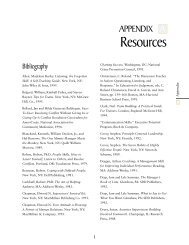MAKE IT LAST FOREVER: THE ... - National Service Resource Center
MAKE IT LAST FOREVER: THE ... - National Service Resource Center
MAKE IT LAST FOREVER: THE ... - National Service Resource Center
Create successful ePaper yourself
Turn your PDF publications into a flip-book with our unique Google optimized e-Paper software.
Second, many youth, having been defined as at-risk for exhibiting certain behaviors, are living up to the label. As parents or<br />
other elders are often unavailable to children, the responsibility for building character and self-esteem has gradually been turned over<br />
to the schools. Whereas churches and families were once the teachers of values and interpersonal skills, schools are now assuming a<br />
greater role in this.<br />
Finally, as many students are graduating without the skills necessary to function in the economy or without the inclination to<br />
participate in community and national decision-making processes, many adults stress the need for students to understand and become<br />
active in the community. Whereas once the learning of intellectual concepts was adequate preparation for democracy and the<br />
workplace, now these preparations seem to no longer be adequate.<br />
It is for these primary reasons that schools are now expected to introduce, promote, and practice concepts such as citizenship,<br />
character, career readiness, social skills, community, and prevention. Initiatives such as Character Counts, School-to-Work, conflict<br />
resolution training, Safe and Drug Free Schools, Communities in Schools, and the Improving America’s School Act “title” programs<br />
are testament to this shift in school purpose over the past 30 years. Of course, this is in addition to the primary goal of increasing<br />
student academic achievement. The schools are charged with ensuring that students leave high school prepared to enter the “real”<br />
world, able to attain higher levels of education and a role in the economy while also having good values and attitudes.<br />
Educators have recognized that they simply cannot do this task alone. Teachers in particular have a difficult time as it is<br />
addressing academic content, and so it is not surprising that they are overwhelmed by the expectation of also adopting the roles of<br />
social worker, therapist, parent, clergyman, advocate, and job trainer. Therefore, many citizens and educators alike have called for a<br />
blurring of the distinctions between schools and communities, redistributing the responsibility of helping youth, and redefining the<br />
schools to serve a more civic purpose. The underlying goal is to help young people to develop a place of leadership within their<br />
communities, so that they will feel connected to where they live and therefore see the relevance of their studies. Schools have been too<br />
isolated from their contexts, people suggest, and communities are so dissatisfied with what’s happening in schools that they are now<br />
interested in being of assistance. Out of this crises there seems to be an emerging opportunity for positive change.<br />
Thus, to improve academic performance and self-esteem while making a difference in communities, service-learning has<br />
emerged during the past 12 years as a primary strategy for achieving educational and community goals simultaneously. Its ability to<br />
stack these functions explains why there are over 250 expert service-learning advocates in the country today. <strong>Service</strong> learning can<br />
build character, expose youth to careers, facilitate cooperation, cultivate healthy lifestyles, and transform the school into community<br />
centers, while assisting all learners, even the most disadvantaged, in succeeding at school. <strong>Service</strong>-learning addresses all academic<br />
areas, and is proving to improve performance in these areas as well. It builds self-esteem and a sense of belonging. It motivates many<br />
students to pursue higher education to achieve their dreams. <strong>Service</strong>-learning is a method used to improve academic performance;<br />
perhaps more important is its capacity to bring out the quality of caring in people. For the world needs love, and as long as society is<br />
giving the schools additional responsibilities, spreading love certainly deserves to be at the top of the list.<br />
The Process of Educational Reform<br />
<strong>Service</strong>-learning is not the only method of educational reform actively being promoted in this country, and as such, it must<br />
compete for attention with numerous initiatives to improve teaching, school design, and academic performance. <strong>Service</strong> learning is not<br />
a major focal point of any of the major restructuring initiatives in the United States. <strong>Service</strong>-learning has not been driven by the US<br />
Department of Education (DOE), and so has faced an uphill battle finding its place as a serious pedagogical approach among policy<br />
makers, practitioners, and researchers. While this is shifting, thanks in part to recent research and joint statements by the DOE and the<br />
22



